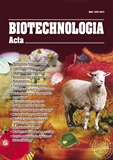ISSN 2410-7751 (Print)
ISSN 2410-776X (Online)

Biotechnologia Acta Т. 17, No. 2 , 2024
P. 44-45, Bibliography 5, Engl.
UDC::612.323
DOI:https://doi.org/10.15407/biotech17.02.044
BIOCHEMICAL INDICATORS OF GASTRIC JUICE IN INCOMPETENCE OF THE PHYSIOLOGICAL GASTRIC CARDIA
A.M. Halinska 1,2, O.V. Severynovska 2
1 State Institution “Institute of Gastroenterology of the National Academy of Medical Sciences of Ukraine”, Kyiv
2 Oles Honchar Dnipro National University, Ukraine.
Aim. This study aimed to evaluate the biochemical characteristics of gastric juice in cases of incompetence of the physiological cardia (IPC) at the gastroesophageal junction.
Methods. Gastric juice samples were collected from 42 patients diagnosed with hiatal hernia (HH) at the State Institution "Institute of Gastroenterology of the National Academy of Medical Sciences of Ukraine." Patients were classified into type I (sliding) HH (n=26) and type II (paraesophageal) HH (n=16), with a control group of healthy volunteers (n=9).
Results. The analysis included pH, pepsin concentration, bile acids, total calcium, and stable nitric oxide (NOx) metabolites. In type I HH, gastric juice showed increased pH (3.73±0.49) and elevated pepsin concentration (1.33±0.22 mg/ml) compared to controls (p<0.01 and P<0.05, respectively), indicating hypoacidity and hyperfunction of chief cells. Type II HH exhibited pH levels (2.34±0.72) similar to controls and no significant difference in pepsin concentration. NOx levels in type I HH were lower (P<0.05) compared to than controls, suggesting reduced NOergic system activity. Calcium concentration in gastric juice did not significantly differ between groups.
Conclusions. These findings suggest that type I HH is associated with disturbances in gastric secretion regulation, possibly unrelated to duodenogastric reflux. Further investigation is warranted to elucidate the underlying pathophysiological mechanisms.
Key words: incompetence of the physiological cardia, gastric juice, hiatal hernia.
© Palladin Institute of Biochemistry of National Academy of Sciences of Ukraine, 2024

